SPRING 2023
The joys of volunteering — Birds making some noise — Nature's own Eurovision song contest
Our vibrant nature reserves
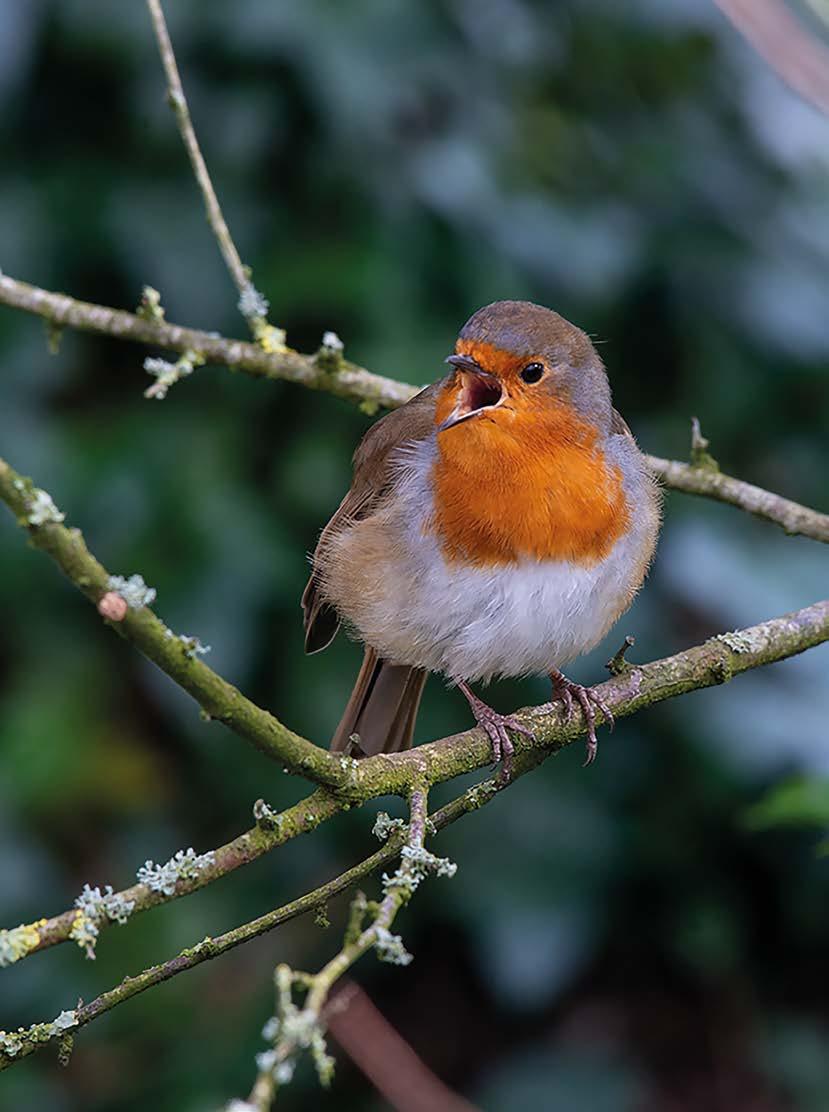
www.lancswt.org.uk Protecting Wildlife for the Future
Senior Trust Officers
Patrons
Edwin Booth, Dame Caroline Swift
President
Chris Davies
Honorary Vice Presidents
Baroness Williams of Trafford,
Vice President
Ted Jackson MBE
Chairman
Julian Jackson
Vice Chair
Hazel Ryan
Honorary Treasurer
Nicholas Williams
Chief Executive
Tom Burditt
Director of Conservation
Tim Mitcham
Director of Marketing
Lindsey Shaw
Director of Development
Mick Weston
Director of Nature and Wellbeing
Daveen Wallis
Director of Finance
Steve Wood
Editors
Alan Wright
E. awright@lancswt.org.uk
Sub Editors
Jenny Bennion, Roland Howard, Molly Toal, Danielle Shaw, Jenny Johnson & Kirsty Tyler
Trust Headquarters
The Barn, Berkeley Drive, Bamber Bridge, Preston PR5 6BY T. 01772 324129 www.lancswt.org.uk
Design
www.nectarcreative.com
Cover photography
Robin singing by Peter Smith
Lapwing is produced for the Members and Supporters of The Wildlife Trust for Lancashire, Manchester and North Merseyside. Views expressed here are not necessarily those of the Trust.
The Lancashire Wildlife Trust is a Registered Charity (No.229325) and a Registered Company (No.731548) dedicated to the protection and promotion of wildlife in Lancashire, seven boroughs of Greater Manchester and four of Merseyside, all lying North of the River Mersey.

If I asked you to name your local nature reserve, what would you say? Brockholes?
Mere Sands Wood? Lunt Meadows?
Wigan Flashes?
Astley?
www.lancswt.org.uk 2 Supporting your special places for nature...
KEEPING IN TOUCH You can change the way we contact you, or update
Did you know that your Wildlife Trust owns or manages more than 40 nature reserves in the North West from the tiny Over Kellet Pond to the vast peatland reserves at Winmarleigh and
Snowdrops by Alan Wright
We want to introduce all our members and supporters to these wonderful pockets of nature, which are vital links in the Nature Recovery Network, spreading across the whole of the United Kingdom. Over the next few pages, we will tell you all about those reserves and how you can get involved in visiting them and supporting the work we do. More than anything, we believe you, our members, can help us the spread the word about these glorious places for plants and creatures (Pages 4-7).
We also need to see more volunteers helping our officers to create habitats on reserves. Volunteering can be hard work but everyone is making a difference as well as improving their physical and mental health and having a good time. It’s a great way to make new friends.
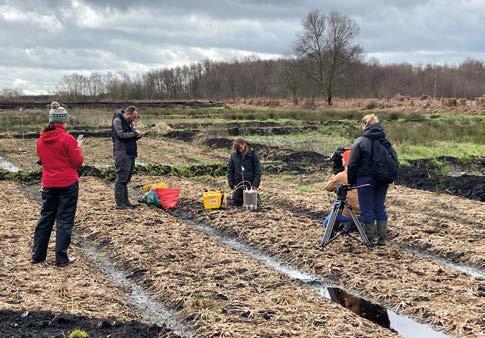
So, we will be hearing stories from some of our volunteers, they are heartwarming tales and certainly made me want to join them as much as possible on their work parties (12-15).
In the past few weeks, our friends at Eden Morecambe have been given the funding to go ahead with their amazing plans to bring the natural world to the seafront at Morecambe. This will be a wonderful addition to Morecambe’s panoramic sea front. You can read how we have been working with the Eden team and others using nature as a prescription to problems of depression and loneliness around Morecambe Bay (20-21).
Spring is an exciting time of year and the appearance of swifts is celebrated by our local expert Louise, who is also a member of our knowledgeable speaker team, which spreads the word across the region (24-25).
your details by speaking to our membership team: E:

And many of you will be enjoying the dawn chorus at the moment, even if you are lying in bed. This really is the time that Nature wakes up and shouts out that it’s good to be alive (22-23).
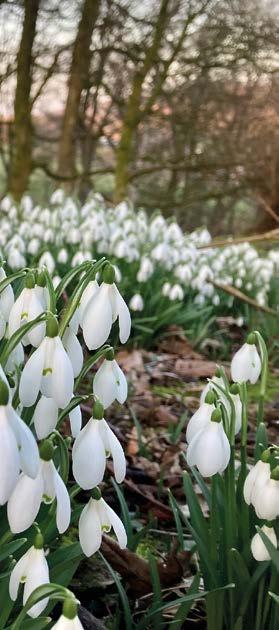
I recommend an early morning stroll through the reed beds at Brockholes for a dawn chorus experience you will never forget. Warblers and reed buntings really make a racket. It’s deafening but it makes you feel great for the rest of the day.
As always, I want to stress just how important your membership is to the Trust and to nature in Lancashire, Manchester and North Merseyside. Please pop into our nature reserves and see how your support is creating perfect habitats for a diverse range of plants and creatures.
Tom Burditt, Chief Executive Officer

@Lancashirewildlifetrust 3 @lancswildlife
membership@lancswt.org.uk (01772) 324129
"Volunteering can be hard work but everyone is making a difference as well as improving their physical and mental health and having a good time."
Countryfile featured Rindle Moss in Salford, as we discussed paludiculture or wet farming
www.lancswt. org.uk
The Wildlife Trust campaigns for issues that affect you
Our nature reserves mean so much...
Our nature reserves offer so much to wildlife and people, but how many people realise the vitally important work that is carried out on every one of those wild places every day of the year? Our new campaign to spread the word starts here...
In this issue of Lapwing, we are launching our Nature Reserves Campaign to let people in on the secret that you, our members, know all about.
Let us begin by discussing the question “What is a nature reserve?” A nature reserve is a haven for wildlife to flourish. It can be one huge wetland or woodland, or a range of habitats, like Brockholes, Mere Sands Wood and Wigan Flashes.
Most of our reserves have a variety of habitats, offering feeding grounds and safe areas for creatures who live on the reserve or are just popping in.

One of my favourite stories is about lapwings on our island in Number One Pit at Brockholes. We have used conservation grazing sheep and volunteers to clear the island for spring every year.
This meant lapwings could nest and be able to look around pretty much the whole island, to see if dangers were lurking. When chicks were born and started to run around, the plants around them grew and eventually created a canopy, hiding them from predators and the summer sun. Our work helped this dynamic partnership between plants and birds.
Our nature reserves are places where plants can grow and mammals, birds and insects can nest and breed. While Nature has taken over vast industrial complexes, it still needs a little help from its LWT friends to retain fabulous habitats.
Some of our reserves provide homes for the willow tit, Britain’s most endangered small bird, the Manchester argus, a butterfly that hadn’t flown in the county for 150 years, and many rare and unusual species, orchids are everywhere in summer.
Our reserves are also inhabited during the day by volunteers, taking action for nature. We have conservation volunteers, friendly staff in our shops and cafes, and people supporting in our offices, all of whom take a pride in working in wild and not-so-wild places.
I honestly think that a lot of our wonderful peatland volunteers see the mosses as an extension to their own gardens. They work so hard and get a lot of satisfaction from balsam bashing, planting and scrub clearance, all vitally important jobs.
www.lancswt.org.uk 4
Nature Reserves
"Our nature reserves are places where plants can grow and mammals, birds and insects can nest and breed."
The view across Morecambe Bay from Warton Crag by Alan Wright
Volunteers create rides – or pathways – for handsome fritillaries, plant vibrant sundews, put up boxes for pied flycatchers and seed wildflower meadows for buzzing bees and flittering butterflies. They also mend fences and gates and tidy paths for another important element of our nature reserves, our visitors. The first aim of our Nature Reserves campaign is to welcome more visitors, who will support the work that the Lancashire Wildlife Trust is doing. They can come along to the reserves and tell all their friends what glorious places they are. >>>
How you can get involved...
— Visit our accessible nature reserves
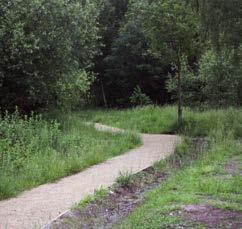
— Tell people about our reserves on your social media
— ...and send us your pictures or copy us into your messages
— Invite your friends and family to our reserves
— Ask your employers about work-days
— Hold meetings in our conference facilities and cafes
— Ask you employers to support our nature reserves
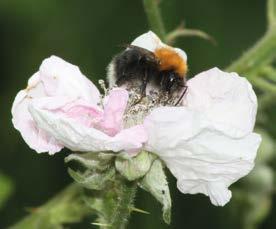
— Tell everyone about how important nature reserves are for wildlife
— Think about leaving a legacy to nature
— Volunteer on a nature reserve
— Apply for a job at the Wildlife Trust
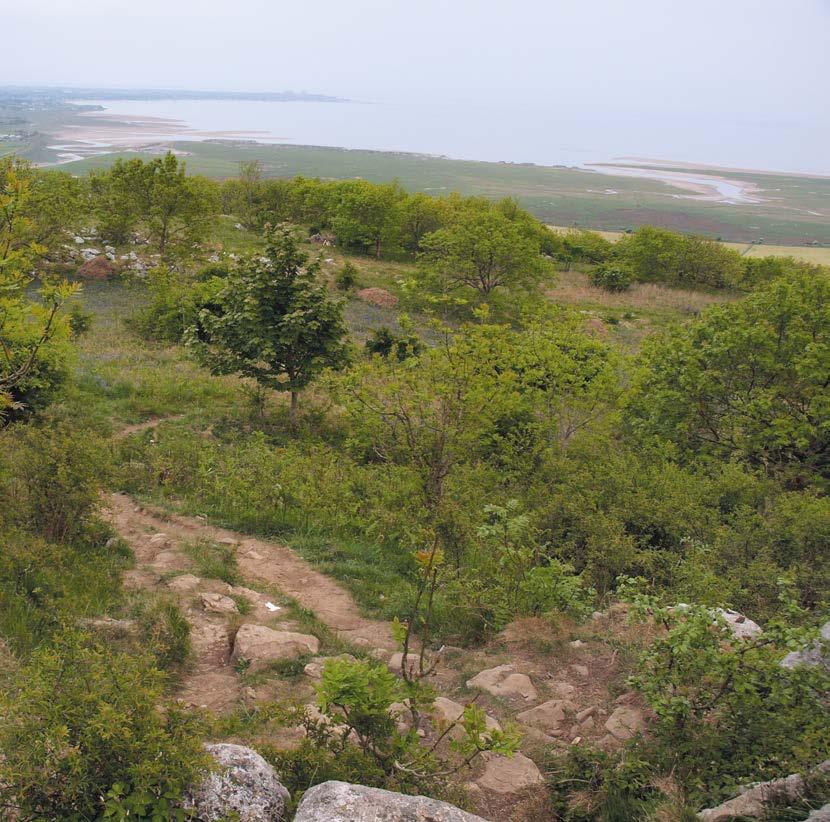
@Lancashirewildlifetrust 5 @lancswildlife
Tree bumblebee by Alan Wright
Moston Fairway close to Manchester City Centre by Alan Wright
>>> I have been to all of our nature reserves including a marathon 37, during 30 Days Wild, a couple of years ago. I watched peregrines hunting around the cliffs at Warton Crag, close to Carnforth, a dipper dibbling on the Eagley Brook at Longworth Clough, red squirrels at Freshfield Dune Heath in Formby, and brown hares at Brockholes.
I also went up on the moors close to Nelson, to Upper Coldwell Reservoir and built a bridge to help some ducklings follow their mum over a tall wall. They didn’t seem grateful, just annoyed, although when they paddled off in the water, I am sure the mother looked back and smiled.
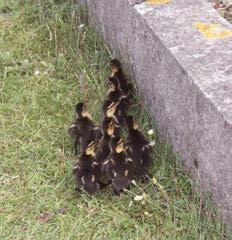
Longworth Clough, in Belmont, is close to my home now, and I love spring there, with the smell of wild garlic on the steep paths down into the valley. And our mosslands are presently covered in sheets of white and fluffy cottongrass that dances in the wind.
Of course, you may be lucky enough to see rarities on our reserves but what you will see, hear and feel is the nature within the old boundaries of Lancashire encapsulated with tiny 11 hectares (Over Kellet Pond) or vast 107 hectares (Little Woolden Moss).

It is important that the work on individual reserves is recognised as part of our wider work across Lancashire. The Nature Reserves Campaign will raise the profile of all of our reserves but it is up to our members and supporters to get the message out to the many people who haven’t had wonderful experiences in these wild places.
Our visitors are as varied as the wildlife – young families and school groups share hides with birders and other naturalists, fungi experts comb our woodlands in autumn while work parties from local businesses balsam bash nearby, walkers and cyclists politely make way for each other, students use real-life encounters to bring exam papers to life.
We love chatting to parents who are picking up knowledge that they can pass on to their children and to their mates down the pub - that really happens!
All of them are creating their own opportunities to have their “Attenborough moment”, when they see something wild and amazing.
Our nature reserves are no secret, go to our website and you can find details about the ones you can visit and the ones you can pop into with your well-behaved dog.
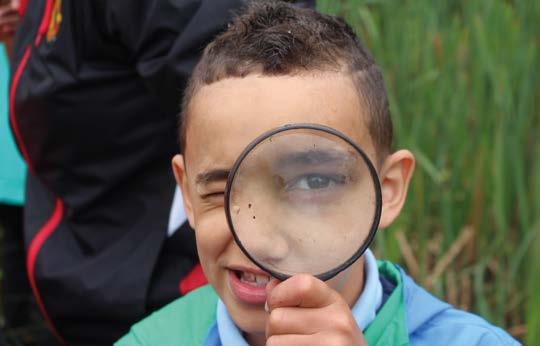
Some can only be visited with a licence and we can arrange trips to private reserves for interested groups and individuals.

www.lancswt.org.uk 6
"We love chatting to parents who are picking up knowledge that they can pass on to their children and to their mates down the pub - that really happens!"
A secret waterfalll on a Bolton nature reserve by Alan Wright
Large red damselfly at Abram Flash by Alan Wright
Nature Reserves
Ducklings in need of help at Upper Coldwell Reservoir by Alan Wright
Heysham Moss
Barnaby’s Sands and Burrows Marsh
Some of the highlights you may spot on our reserves
WILLOW TITS – Wigan Flashes
BOG BUSH CRICKET – Little Woolden Moss
BITTERN – Mere Sands Wood
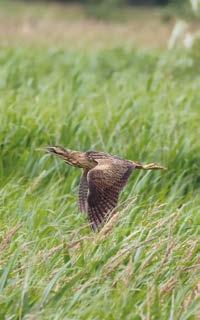
OTTER – Brockholes
PEARL-BORDERED FRITILLARY – Warton Crag
PEREGRINE – Salthill Quarry
COTTONGRASS – Moston Fairway
SHORT-EARED OWL – Lunt Meadows
COMMON TERN – Seaforth

RED SQUIRREL – Freshfield Dune Heath
BLUEBELLS – Aughton Woods
KINGFISHER – Foxhill Bank
DIPPER – Longworth Clough

MINING BEES – Highfield Moss
And don’t forget the RABBIT ROCKS at Kirkless
Warton Crag
Over Kellet Pond
Aughton Woods
Freeman’s Pools
Haysham Nature Reserve
Middleton Nature Reserve
Discover our accessible nature reserves and how to get to them on our website www.lancswt. org.uk
Winmarleigh Moss
Mere Sands Wood
Freshfield Dune Heath
Lunt Meadows
Seaforth Holiday Moss
Boilton, Redscar and Tunbrook Woods
Brockholes
Moor Piece Cop Lane
Willow Farm Wood
Dean Wood
Freeman’s Pasture
Longworth Clough
Red Moss Kirkless
Wigan Flashes
Lighshaw Meadows
Highfield Moss
Crosshill Quarry
Salthill Quarry Fox Hill Bank
Cutacre
Astley Moss
Rindle Moss
Little Woolden and Cadishead Moss
Summerseat Island
Moston Fairway
7 @lancswildlife
@Lancashirewildlifetrust
Common tern at Seaforth Nature Reserve within the Liverpool Docks by Alan Wright
Bittern flying over the reedbed at Lunt by Phil Boardman
Inspired by the beautiful Bay
The other day I had the honour of being invited to Rossall Point in Fleetwood. I was presenting John Muir Awards to a number of proud participants who had completed their time with The Bay nature and wellbeing programme there.

It was to recognise the actions they had done for nature over a three-month period: 11 bags of beach-clean litter collected, 688 trees planted, 44 hours of scrub and invasive species removal, 42 wildlife habitats created, 87 bird feeders made, and 221 shark egg case records submitted to the Shark Trust’s citizen science monitoring.
You can read more about The Bay and the fantastic news surrounding Eden Morecambe on pages 20 & 21
But I also heard about the friendships made, the confidence and wellbeing that had grown, the lives getting back on track, and the love of nature that had been allowed to flourish.
At the end we stood on the beach with the wind blowing in our hair, skylarks singing overhead, the sounds of the tide roaring in, and with linnets, ringed plovers and turnstones scampering and flitting around us .Mike, the Trust’s Nature and Wellbeing Officer read out some very appropriate words written by the great John Muir 150 years ago:
“Nature is always lovely, invincible and glad, whatever is done and suffered by her creatures. All scars she heals, whether in rocks or water or sky or hearts.”
Since childhood I have always found trips to our British seaside unbelievably magical; and now as an adult living close to Morecambe Bay it is still the sea that I turn to when I am in need of solace, comfort and reflection; as a source of strength and inspiration.
I love watching sparkles of light on the waves, the comings and goings of the
www.lancswt.org.uk 8
Tom ' s View
sculpted silty channels, the peeping of oystercatchers and the more mournful cry of the curlew; the days when sea and sky meet in a flatness of grey; the storm surges of a high spring tide; the sheer expanse of it all. It is an almost spiritual feeling of connection to something bigger, wilder, freer, more untameable than our everyday life, and when I’m blue it never ceases to make me feel better. Most of all I love pottering about beachcombing and the little glimpses it gives in to the secret world out there under the waves. The crispy, leathery mermaids’ purses on the strandline are a great place to start.
Every time I find one I want to scream “Everything is going to be OK!" Because there are sharks out there! beautiful spotted cat sharks, living, thriving and still having pups!”. Thornback ray eggcases are another common find, veritable dragons that can grow up to 1.4m long and the same across their wingspan. I once found the eggcase of a nursehound shark. They are out there in our seas and they’re 1.6m long. They’re incredible, and harmless to humans.
My other favourites to come across are the mysterious colonial lifeforms. On our beach I regularly find a fossil coral from the Carboniferous period called Siphonophyllia. But if you’re lucky then on the rockier bits of our Lancashire coastline you might come across a modern day living reef made by thousands of Honeycomb worms (Sabellaria alveolata), who create massive structures of interlinked sandy tubes as their home. Or if you’ve ever picked up a hornwrack on a beach, it may look like a scaly seaweed frond but it is actually a bryozoan – a colony of individual animals known as zooids (or “moss animals”).
If you look at one under a microscope or hand lens you might be lucky enough to see each tiny box with its fan-shaped feeding tentacles sticking out. Both of these are tastes of what lies just off the Fleetwood shore in the “Lune deep”: a 70m deep rocky trench designated as a Special Area of Conservation and home to whole living carpets of bryozoans, spectacular feathery peacock worms (a relative of the honeycomb worms), and hydrozoans which are a kind of colonial animal that can look coral-like when attached to the reef on stalks, or they can resemble jellyfish when they are free floating.
This incredible habitat is, in turn, a home to squat lobsters, salmon, spurdog sharks and giant dogfish. And a tiny bit further offshore are the quahog clams which can live for hundreds of years and are the oldest animal on the planet.
It’s a whole hidden world, infinitely precious. And it may feel wild and exotic, but like every corner of our planet it sadly faces a multitude of threats: from pollution, climate change, bottom trawling and inappropriate marine development. Our Wildlife Trust's Living Seas team are promoting visibility and understanding of these incredible places, campaigning for Highly Protected Marine Areas, promoting sustainable fishing, monitoring North West marine and coastal wildlife, and developing the Irish Sea Vision. The Our Future Coast project is looking at promoting nature-based saltmarsh and sand dune coastal defences over concrete ones.
You can help us by supporting one of our marine campaigns, joining a beach clean, or by avoiding fish or shellfish that have been caught with bottom-towed fishing gear.


We know in our hearts what John Muir knew: that being by the sea can heal us; now it’s time for us to help to heal her.

@Lancashirewildlifetrust 9 @lancswildlife
" Since childhood I have always found trips to our British seaside unbelievably magical ; and now as an adult living close to Morecambe Bay it is still the sea that I turn to when I am in need of solace, comfort and reflection "
Cleaning the beach at Fleetwood
Tom and Mike McDonnell, fourth and third from right, present the John Muir Awards
The little bird with the big voice
Jenny Bennion delves into the world of the wren, the garden familiar who is more often heard than seen.

www.lancswt.org.uk 10 Wildlife
Singing Wren by Andy Rouse/2020VISION
I’ve always loved wrens, ever since being a child and being referred to as "Little Jenny Wren". I still have a necklace, the pendant being a wren on an old farthing coin. However, these diminutive garden birds have a surprising superpower –their voice. Weighing little more than a pound coin, only the goldcrest is a smaller feathered visitor to our garden, the wren has one of the loudest songs of all garden birds.
It’s hard not to be enthralled when catching a glimpse of the everindustrious wren. Dappled brown plumage, fading to a paler underbelly is topped with a remarkably erect tail, seeming like a cantilever to its round body. Often described as "dumpy" this seems like a cruel term for the teddy bear rotundness of this charming little bird.
The word wren is thought to come from the Anglo-Saxon wrœnno, meaning lascivious. These days it infers lewd or lustful, but in older times it was applied to people who were small, busy, quick and energetic - just like the bird that we see flitting around our gardens. Their wings blur with an almost hummingbird speed as they zoom in and out of shelter searching for their favourite food of insects and spiders.
The wren’s Latin name, troglodytes, means cave-dweller and refers to their habit of squeezing into small cracks and crevices in rocks, around fallen branches, in bushes and undergrowth, either to find food or to build nests.

Folklore holds the wren as the King of the Birds. The story goes that all the birds gathered to decide the crown by seeing who could fly the highest. The eagle easily won this contest, only to be pipped at the post by an industrious wren who had hitched a ride on its back and leapt into the air at the last moment.
History aside it is their song that really makes the wren the King of the birds for me. Pound for pound the wren’s voice is reputedly ten times louder than a cockerels’ morning crow. Their song usually consists of a flurry of high-pitched, metallic, ringing notes interspersed with softer trills, usually in the second half of their five to seven-second song.
Like all birds, the wren’s song is produced by the syrinx, or voice-box. This is located at the far end of their larynx just above the lungs and is dual chambered which allows them to sing two notes simultaneously. And wrens do this with great gusto to create their jubilant and loud song.
Wrens are naturally territorial, and this is thought to be why they have such a magnificent song. During breeding season males build several domed nests made of moss, lichen and leaves, throughout their territory. The females then conduct a series of viewings before choosing their preferred nest and lining it with feathers.
A clutch of five to seven white eggs speckled with red are laid, hatching around two weeks later, and fledging after a further 15 to 20 days. A second brood usually follows. At this time the female really comes into her voice, singing loudly to deter anything that may threaten her nest.
Whilst wrens might be our most common breeding bird, with 8.6 million breeding territories, a hard winter can see their numbers fall significantly.
Taking simple steps such as leaving lots as messy areas in your garden for wrens to nest, shelter and forage in can make all the difference for this tiny but noisy garden favourite.
@Lancashirewildlifetrust 11 @lancswildlife
"Weighing little more than a pound coin, only the goldcrest is a smaller feathered visitor to our garden, the wren has one of the loudest songs of all garden birds."
"Pound for pound the wren’s voice is reputedly ten times louder than a cockerels’ morning crow."
Look out for wrens in your garden searching for insects in walls or in trees. You can't miss that prominent tail
Wren by Margaret Holland
Volunteers make a difference
Your Wildlife Trust first got involved with Ashton’s Field in 2018 when the owners, The Land Trust, appointed us as site managers. This nine-hectare site in Salford is a former coal mine squashed between a motorway, gradually spreading industrial estates and a large housing estate. In many ways that description makes it sound unpromising and I’m sure won’t make you want to rush out to visit.
Despite this it is an oasis of green space providing a lifeline for the surrounding communities whether it be through a quiet walk to get the baby to sleep, five minutes of peace on the way home from school, a space to walk the dog or to undertake exercise through Couch to 5K.
When we first became involved we found that the site was well loved but "nature" wasn’t really part of the thinking as we spoke to people. Many couldn’t understand what we were doing and perceived that we were letting the site become untidy by not cutting the grass. When we repollarded a row of trees we were accused of vandalism. Creating new ponds was "attracting rats".
Often as an employee of a conservation organisation we can receive backlash from people who see us as being from outside the community and imposing our ideas on them. Our secret weapon is our wonderful volunteers. It’s hard to argue with someone who believes in something so strongly that they’ve given up their precious time for it.
Our wonderful volunteers have tackled every job you can think of on site from planting native wildflowers in the plantation woodland, to digging new ponds and scrapes, removing invasive species, hedgelaying, coppicing, grass cutting and raking, sowing yellow rattle to tidying up after raves, daily litter picking, weekly bird surveys, small mammal surveys, grassland surveys, leading bat walks and dawn choruses… all with a smile on their faces whatever the weather.


Over time the work that our volunteers do and the conversations they have whilst on site have won over the community as more and more people get involved, approach us to ask questions and make suggestions about what we should do or how we should do it.
It turns out that for many people nature was always part of the thinking about the site but people didn’t have a community to share it with.
I’m sure all our volunteers know that whenever they pick up a spade, report a wildlife sighting or help at an event that they are contributing to the work of the Trust and to wildlife. I hope they know that they are also fostering a community, spreading enthusiasm and inspiration and providing the crutch that we need as staff from time to time when criticism gets a bit too much.
Thank you to all our fantastic volunteers, you are all superstars and make the Wildlife Trusts and the sites we work on such a wonderful place to be.
www.lancswt.org.uk 12 Our Wonderful Volunteers
Turning former industrial areas into places for wildlife would not be possible without our excellent volunteers Stephen Cartwright tells us.
"Often as an employee of a conservation organisation we can receive backlash from people who see us as being from outside the community and imposing our ideas on them."
Hedge-laying gang gives the thumbs up ... photos by Jane Arkwright and Stephen Cartwright
Nora gets to work
Volunteers are the heartbeat of Lancashire Wildlife Trust. The many hundreds of volunteers give thousands of hours of their time to the Trust every year.
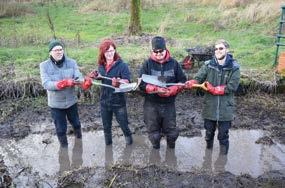


They help more people engage, connect and care about the environment both in rural and urban settings.
The range of volunteering roles they undertake for The Trust is astounding. The roles include craft volunteers, species recorders, red squirrel volunteers, maintenance volunteers, welcome centre volunteers, Trustees, Youth Council, and Speaker Team to name a few.
Some volunteers help out in more than one role or location on a diverse range of tasks.
Many have volunteered with the Trust for decades. Without our volunteers incredible passion and commitment the Trust would cease to achieve what it does for the natural world and people in our region.

 Emma Bartlett Volunteer Manager
Emma Bartlett Volunteer Manager
@Lancashirewildlifetrust 13 @lancswildlife
Keith shifts some grass
It can be muddy work
Harold with his loppers
Cath and Craig brave the snow
Jamie’s volunteer story
I’m Jamie, a volunteer for the Nature and Wellbeing service in the Lancashire Wildlife Trust. My time is spent between the Blackburn greenhouse project and Chorley allotments, where I began my journey.



I heard about Myplace - now the nature and wellbeing service – through my psychologist. My dad had been looking for possible job or volunteer opportunities to help me get out and improve my mental health, as well as practice my social skills that I’ve struggled with due to my Asperger’s.
We had a chat with Jo, the Chorley project officer, and discussed what activities we would do on the sessions such as gardening, bush craft and going on nature walks. I began as a participant in November of 2021 and after a lot of learning and building up my confidence, signed up as a volunteer.
Since my volunteering is about wellbeing, It’s a different experience to that of a conservation volunteer. My main focus is on making participants feel welcomed and understood, as well as supervising while we carry out conservation tasks and maintain our allotment. I know what it’s like for people who are lonely or struggle with their mental health, having been through it all myself, and I’m so glad I can use my experience in a positive way by helping similar people.


I think it’s important we realise how much we can help ourselves physically and mentally through nature, and that simply being outside connecting and helping people as well as wildlife is a healing experience. It’s so rewarding seeing people gain confidence and skills every week, and knowing I am a part of that process. I believe it’s important to be kind most of all, to those around us and to nature, and through this we are rewarded with a better future for everyone.
I truly feel I can now look forward in life, eager to help out every week and progress, rather than looking back to the past and wishing I’d done more. Volunteering is the best thing I’ve ever done and I’m still learning and growing all the time.
I’ve always felt understood and welcomed unconditionally even when I haven’t felt 100%, which has helped me to appreciate who I am despite any challenges I have to overcome. I’d like to encourage you to join us, no matter your background or ability, as everyone has something to give back to nature and others, whether it’s their strength, knowledge or kindness.
www.lancswt.org.uk 14
Our Wonderful Volunteers
Panning for history
Making a fishing net
Jamie stands back as he is firelighting
Carol on a sea watch
Lunt Meadows Archaeology Volunteer, Lizzie Ehlen
Lizzie has been an archaeology volunteer for the Merseyside team’s Mesolithic and Modern Life Project since 2021, after attending a webinar all about Lunt Meadow’s stone age past and life in the Mesolithic (Middle Stone Age).
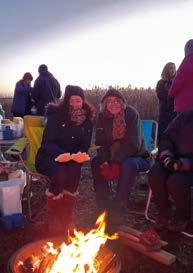
Initially, Lizzie became involved because she was interested in learning experimental archaeology skills. With training from project partners, the University of Chester Archaeology and History Department, Lunt volunteers, like Lizzie, have been learning how to make everyday Stone Age items. This is with the aim of sharing these skills on public workshops on the nature reserve and in the community.
There are still lots of skills to learn, but Lizzie has already been able to teach the public how to use a bow drill, make cordage from plants and make a fishing net on Stone Age craft days.
Lizzie’s involvement hasn’t stopped here either, as she gets involved in the many other areas of archaeology at Lunt. Lizzie is helping the Museum of Liverpool’s Curator of Prehistoric Archaeology and project partner, Ron Cowell, excavate the remains of Lunt Meadows’ 9000-yearold camp.
Lizzie also helps the Lunt team to ‘sieve’ or pan bags of soil excavated from the dig site, interpreting their contents, and recording any organic remains or stone tools.
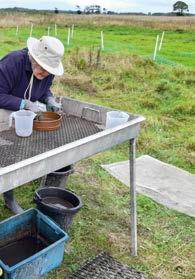
Bay Volunteers
During school holidays, Lizzie assists with public panning events too, enabling children and adults to have a go at panning for themselves. It can be difficult to know what you are looking for in the soil when you first have a go at panning, so Lizzie explains how to identify and record the different items that are found, such as burned hazelnut shells, charcoal, or stone tools (called microliths).
After these events, Lizzie works alongside other volunteers to organize the items found and input the hand-written records from panning into a spreadsheet on the computer. Once all the information is digitized, the team can produce maps and look at how stone age people used the different sections of the camp to carry out activities.
Getting involved in the archaeology work at Lunt Meadows is a chance to learn specialist hands-on skills with a supportive and friendly group of people who share an interest in history and archaeology.
By volunteering, Lizzie is not only helping the project team and Lunt’s visitors learn about the nature reserve’s special heritage, she is contributing to nationally significant research about this fascinating time in human history.
Here at The Bay: Blueprint for Recovery, we are fortunate to have some wonderful volunteers who we rely on to help run our Nature & Wellbeing sessions and community events.
Carol and Owen Fawcett are two enthusiastic and dedicated Bay volunteers, who we would like to give a special thanks to and spotlight their hard work.
Their knowledge on local wildlife is an asset to our team, with Owen regularly teaching us all about the different Lichen’s he has found, and how to classify them. Their extensive knowledge has been particularly useful on helping on events such as wildflower walks, strandline surveys and beach cleans. Not only do they volunteer regularly at our community events, but they are also very keen shark egg case hunters.
Last year alone they collected 7,241 egg cases. Thanks to their efforts they have awarded the Bay a spot in the top 5 shark egg case hunters in the whole UK! Carol told us “It's the Shark Trust 20th anniversary in 2023 and we are really looking forward to more egg case hunt events with The Bay.”
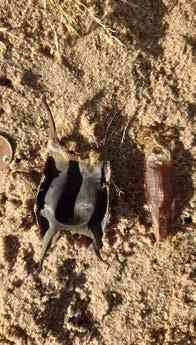
The Bay; Blueprint for recovery, runs free events every month across the whole of Morecambe area, from Fleetwood to Barrow.
If you would like to join us on our events, check out thebay.org.uk/events to find out more. Chloe Desmond, Trainee for The Bay: Blueprint for Recovery (Wyre Team).
@Lancashirewildlifetrust 15 @lancswildlife
Lizzie and Lisa keeping warm
Boom bang a bang bittern...
This May the UK will be welcoming song lovers from across the globe as Liverpool hosts the Eurovision Song Contest. But Eurovision fans aren’t the only visitors flocking to our shores...
Lunt Meadows Communications and Engagement Officer (and Liverbird), Molly Toal , introduces her top spring and summer migratory birds.
BITTERN
A rare reedbed specialist, the bittern is a member of the heron family with cream and brown-streaked feathers. Approximately 800 bittern overwinter in the UK, but we also get European migrants flying over from The Netherlands in spring, looking to breed.
Bittern are like the novelty act in every Eurovision competition. While they do not sing as such, males have a unique call, known as a boom, that they make in spring to attract females. A booming bittern sounds like somebody blowing over a glass bottle. The sound is low, but can travel miles, and it needs to, as reedbeds are few and far between. Thankfully, your Wildlife Trust is improving and creating new reedbed habitats in the sites it manages. Look out for bittern at Lunt Meadows in Merseyside, Brockholes in Preston or Wigan Flashes in Greater Manchester. Be patient as they are very secretive and shy.

www.lancswt.org.uk 16 Wildlife
A booming bittern by Peter Smith
However, we nature-lovers are all looking forward to, is the arrival of our spring and summer migratory birds. And whether you’re watching Eurovision or wild birds, you’ll be treated to a variety of performances this season, from the bold and colourful, the shy and tuneful, to the downright weird. Here are a few species to keep an eye (or ear) out for.
CHIFFCHAFF
Among our earliest and widespread spring migrants, thousands of these warblers travel to the UK from the Mediterranean and North Africa every March. Chiffchaffs are easily heard belting out their distinctive "chiff chaff chiff chaff" call as they flit from bare branches in woodlands and hedgerows.
Their call is so repetitive that it can border on annoying - so is not dissimilar to some Eurovision songs in that respect.
They are also a bit drab – little and dumpy, with subdued olive-brown feathers and black legs – but they are welcome summer guests, as they are insectivores who like to eat gnats, midges, and flies. Most chiffchaffs leave again in autumn, but some have started staying in southern England all year round.

EUROPEAN BEE-EATER
A rare sight in the UK but appearing more frequently as our climate warms, are flocks of jazzy-coloured European bee-eaters. Around the size of a starling, they are unmistakable with their yellow throats, blue bellies, black eye stripes and russet-red backs fading into orange and yellow. Once limited to Africa and southern Europe, these birds are spreading northwards and, in 2022, eight birds spent the summer in Norfolk.
Bee-eaters raise their chicks as a flock, with previous broods helping the breeding pairs to sit on eggs and feed chicks. As the name suggests, bee-eaters feed on bees, as well as dragonflies, wasps and other flying insects. They are sociable and loud, calling "prroop, prrooop" to each other throughout the day.
If bee-eaters were a band, they’d be 1981 Eurovision winners Bucks Fizz. >>>

@Lancashirewildlifetrust 17 @lancswildlife
Some readers will be looking forward to the UK hosting Eurovision this May, and many of you will not be bothered whatsoever.
Bee-eater by John Bridges
Chiffchaff by Ged Gill
NIGHTINGALE
Remarkably plain-looking for such a popular bird, the little brown-and-grey nightingale steals the spotlight thanks to the male’s beautiful vocals. They have a repertoire of over 1,000 different sounds, because the part of their brain responsible for creating sound is bigger than those of most other birds.

Listen out for nightingales in woodlands and coppices near water from April onwards, where males can be heard singing their hearts out at night, hoping to woo a passing female. There were unconfirmed reports of a nightingle in Preston in 2020.
Come July, nightingales will return to their wintering grounds, with some heading as far as southern Africa. Sadly, they are rare now, but the nightingale’s beautiful and rich song has inspired many creative works over the centuries, including poems and classical music. Ukraine’s 2020 Eurovision entry by electric-folk band Go_A was also centred around a nightingale.
SPOONBILL
The unique-looking spoonbill disappeared from the UK for over 300 years, but made a comeback in 2010, with birds from France and the Netherlands now regular visitors every summer.
They are a similar build to herons, but with brilliant white feathers, and long bills that look like big wooden spoons. They swing these bills from side to side when feeding in shallow water, feeling for frogs, fish, crustaceans and beetles.It used to be said that spoonbills were mostly silent, but when in flocks they are quite noisy, making a range of high-pitched trills and soft honks.
Wetland specialists, spoonbills initially returned only to Norfolk, but they are spreading across England, with occasional sightings in the northwest, including at Lunt Meadows. As conservationists continue to maintain and improve wetlands, it is hoped that these birds will thrive.

www.lancswt.org.uk 18
Wildlife
Nightingale by David Tipling
Spoonbill by Bertie Gregory
HOOPOE
Another colourful character, a hundred or so hoopoe land in UK every spring. This bird is unmistakable with a pinkish-brown body and head-crest, black and white striped wings, and a long curved black beak.

Their call sounds like their name, calling "hoop hoop hoop". They can turn up anywhere in urban or suburban gardens, parks, farmland, and nature reserves, and seeing one is a real treat. It’s even more special if you see this bird when it gets excited, as it will fluff up its headcrest like a mohican.
BLACKCAP

An easily spotted and identifiable summer migrant is the blackcap. A medium-sized warbler only the male has a black cap atop his head, while the female’s cap is gingery-brown. The rest of their bodies are both varying shades of grey.
Heralding from Germany, blackcaps have a lovely melodic song - in contrast to the country’s repeatedly poor performances at Eurovision in recent years - filled with whistles, high-pitched squeaks, and scratches. It could be confused with a blackbird’s song, but is faster and a bit shorter.
Blackcaps are little, but loud, and can be spotted singing from their perch in a tree. Find them in woodlands, scrub and gardens, where they can be a bully at the bird table. Since the 1960s, more German-born blackcaps are overwintering in the UK, and it’s thought to be down to supplementary feeding in gardens.
@Lancashirewildlifetrust 19 @lancswildlife
Boom Bang a Bang by Lulu won the Eurovision Song Contest in 1969.
Every year we receive reports of rare birds possibly blown off course into Lancashire. Please report any rare sightings to your Wildlife Trust
"Listen out for nightingales in woodlands and coppices near water from April onwards... males singing their hearts out at night"
Blackcap by Dave Steel
Hoopoe by Amy Lewis
Morecambe ’ s garden of Eden
Morecambe has thousands of visitors each year with migrating wader populations, but in the next few years it’ll be human visitors too, as Eden Project Morecambe lands on the waterfront, says Kirsty Tyler
Our friends at Eden Morecambe have been awarded £50 million in the second round of the Government’s Levelling Up Fund, which allows the project to move into its next phase.
On the seafront looking out across Morecambe Bay, Eden Morecambe will be a boost to the town, economically and socially. Having a major hub of tourism and education, as well as celebrating this hugely important ecological area, is welcome news to Morecambe and the whole of Lancashire.
Lancashire Wildlife Trust’s Chief Executive Dr Tom Burditt welcomed the news “We are delighted that it looks like Eden is definitely coming to Morecambe permanently.
“We have been working in partnership with the Eden team, the Lancashire and South Cumbria NHS Trust and Cumbria Wildlife Trust for a couple of years on the pioneering The Bay: A Blueprint for Recovery project. We have pooled resources to look at how caring for nature can promote positive health and wellbeing for our residents; and how people, in turn, can help nature, from beach cleans to coastal hay meadows.
“The arrival of Eden will further spotlight the wonderful wild riches of Morecambe Bay, which, with the largest expanse of intertidal mudflats in the UK, is already an Eden for hundreds of thousands of birds.

“We look forward to continuing to work together with them to make sure this wildlife is celebrated, conserved and enhanced; and to promote opportunities for local people to take action for our nature so that all our communities –both wildlife and people - benefit.”
Morecambe Bay is a nature-rich and biodiverse coastline, providing habitat to thousands of species, from molluscs all the way up to seals and dolphins.
www.lancswt.org.uk 20
Health and Wellbeing
Keep up to date with news of Eden Morecambe and The Bay in our e-newsletter sent out to all members
Home to the UK’s largest expanse of intertidal mudflats, which is a hugely important stopover on the migration path of thousands of waders each year, the bay has hidden depths and beauty.



The Eden Project’s experience in teaching people about nature is going to be a major win for wildlife in the North West, particularly on our coast and in the Irish Sea.
Building work is scheduled to start later on this year.

@Lancashirewildlifetrust 21 @lancswildlife
"The arrival of Eden will further spotlight the wonderful wild riches of Morecambe Bay, with the largest expanse of intertidal mudflats in the UK"
"Morecambe Bay is a nature rich and biodiverse coastline, providing habitat to thousands of species of wildlife"
Purple sandpiper by Peter Smith
Oystercatcher flocking to mudflats by Peter Smith
Morecambe waders by Peter Cairns/2020Vision
Artists impression of Eden Morecambe
We meet at dawn
Ellie Sherlock investigates the early morning magic of the dawn chorus and meets some of its characters.
If winter is the time for hitting snooze, thick duvets and comfort food, then spring is all early mornings and bright green smoothies.
And whilst many of us may still be clinging to the pillows, our songbirds are certainly making the most of the new season.
The twinkling early morning medley of the dawn chorus, which rises earlier even than the sun, is actually a war cry carried far across the still air, rising in a dramatic crescendo in May. This is the males, defending their territory and demonstrating their fitness. This is the song of survival. It starts with a robin.
It is usually the chirpy, high-pitched whistles and warbles of the robin that signal the start of the chorus, and, in more built-up areas artificial lighting, from a nearby streetlight may even trigger singing to begin in the middle of the night.
Blackbirds quickly join robins, adding their richer, flutey tones to the harmony. Other birds too begin to take to the stage – listen for the repeated musical phrases of the song thrush, the bright trill of the tiny wren, and the descending scale of notes expertly created by the chaffinch.
As the chorus builds, the characteristic "tea-cher, tea-cher" call of the great tit can be heard, joined also by the elongated verses of the blackcap, hesitant at first, then building in confidence towards the end, a song so sweet it is often mistaken for that of a nightingale.

The chiffchaff, a bird so named for its song (and which should probably be re-named to "chiff-choff-chaff" to more accurately describe the sound) sings its staccato notes in random order to the rising sun.
Some of the last to join the chorus include the dunnock, greenfinch, and goldfinch. All of these calls have speed in common, as though rushed by a mutual sense of urgency to be a part of the show. Whilst the goldfinch’s song is described as tinkling, the greenfinch lets out a nasal, lively trill, and the dunnock squeaks a high-pitched ditty.
www.lancswt.org.uk 22 Wildlife
"It is usually the chirpy, high-pitched whistles and warbles of the robin that signal the start of the chorus"
Did you know there is also a dusk chorus?



Generally considered a more subdued affair, the dusk chorus features birds such as tree sparrows and blue tits, which seem to prefer to sing in the evening.
By now, about half an hour after sunrise, the chorus gradually fades and empty bellies begin to grumble for breakfast.
This spring I challenge you to wake early and head out to the garden or your local park half an hour before sunrise.
Choose a fine, clear day between late April and early June, pack a blanket, perhaps some binoculars, and a flask of hot coffee, and let the birds serenade you from your slumber.
YOUR LAPWING TEAM...
MEGAN KELSALL Partnerships Officer
STEVE GARLAND
Former Chair of Trustees
JENNY JOHNSON
Head of Marketing and Income Generation
ALAN WRIGHT
Head of Campaigns and Communications
JENNY BENNION
Peatlands Communications Officer
LOUISE BENTLEY
Swift expert and member of LWT speaker team
LUCY COXHEAD
Membership Recruitment Officer
ANDREW MATHER
Myplace Project Officer
ELLIE SHERLOCK Campaigns and Communications Officer
MATTHEW SWIFT Marketing Officer
MOLLY TOAL
Lunt Meadows Communications and Engagement Officer
KIRSTY TYLER
Nature & Wellbeing Communications Officer
ALICE WOOD
Marketing Support Officer
@Lancashirewildlifetrust 23 @lancswildlife
DR TOM BURDITT Chief Executive
"As the chorus builds, the characteristic ‘tea-cher, tea-cher’ call of the great tit can be heard, joined also by the elongated verses of the black cap"
Great tit by Mark Hamblin 2020VISION
The delightful song of the blackcap earns this bird the nickname the 'Northern Nightingale' by Vaughn Matthews
Robin singing by Neil Aldridge
Thank you for choosing to live a little wilder
The start of a New Year is a perfect time to kick old habits and start some new ones, and so many of you did so by choosing to support your local wildlife in 2023 by joining as a member, says Lucy
Coxhead
.
Want to live even wilder in 2023? There are so many small changes we can make in our own lives to be more environmentally friendly. Here are some tips from the Lancashire Wildlife Trust team on how you can make 2023 your wildest year yet.

MAKE ROOM FOR NATURE IN YOUR GARDEN

Install a bird or bat box, or how about a hedgehog house or a bug hotel? Even something as simple as a pile of logs and leaving leaf litter can provide a great shelter for invertebrates.
Many butterflies find shelter in leaf litter, either in egg, pupal or adult form, to safely wait out the winter and emerge in spring. Toads and frogs will also snuggle themselves down in a warm log pile or compost heap and snooze the season away.
TAKE A DAY OFF FROM GARDENING AND LET NATURE TAKE OVER
Leave a wild patch in your lawn where you don’t weed or mow, and it will soon be buzzing with wildlife.
If you don’t have a lawn, you could scatter some wildflower seeds in a flowerpot or get crafty and upcycle some household items - that old pair of wellies with holes in could be a perfect planter. Planting wildflowers provides vital resources to support a wide range of insects that couldn't survive in urban areas otherwise.
SPARE A THOUGHT FOR HUNGRY VISITORS
When the weather is cold, a tantalising mixture of high fat -content food (like fat balls or peanut cakes), seeds, nuts, grains and over-ripe fruits like apples and raisins will keep garden birds warm and ensure they're getting a varied diet. If you’re lucky enough to have a prickly visitor, hedgehogs enjoy tucking into a bowl of plain, meat-based cat food.
It’s important to remember to remove any food that doesn’t get eaten overnight and replenish it with fresh food each evening. A little care goes a long way.
LESSEN YOUR GLOBAL FOOTPRINT
The food we eat can have a huge impact on the planet – in fact, a quarter of global emissions come from food alone. Thankfully, there are ways to lessen your footprint whilst still enjoying delicious meals. More than half of food emissions come from animal products, so the easiest change is to cut down on the amount of meat, milk and eggs you consume. How about having a simple meat-free Monday every week?
HELP THE PLANET
Single-use plastic is a global problem, but we can be part of the solution at home. We’ve all heard of the benefits of bringing our own coffee cups, shopping bags and refillable water bottles. If you do these things, then keep up the good work. Maybe it’s time to go one step further. Keep an eye out for unpackaged bar soap, shampoos and conditions and ditch the plastic containers.
If kept out of a water stream, they last a long time. With the rising demand for plastic-free groceries, many places have seen their first refill shops pop up. If you are lucky enough to live near one, buying dried goods like rice and pasta here often works out cheaper too.
www.lancswt.org.uk 24 Our Members
House sparrow by Ben Hall 2020VISION
Stag beetle by Terry Whitaker 2020VISION
We want to thank all our members – whether you have been supporting us for years or recently joined - for continuing to stand by us, helping us to protect wild spaces and inspire others to take action for nature.
Join our team
The Wildlife Trust for Lancashire, Manchester and North Merseyside’s Board of Trustees brings a wealth of knowledge and wide-ranging experience from a variety of sectors. Our trustees are the governing body of the Trust and play key roles in all aspects of our work and the strategic direction that we need to take in times of financial and environmental uncertainty.
Each one has a particular skillset and is able to offer support and invaluable advice to our Wildlife Trust. Being a trustee is a rewarding experience. You would be joining a welcoming group and you will add to your own skills and experience, particularly in strategy and policies. You will need to be a champion for wildlife.
We are recruiting for four new trustees, including two with the following skillsets:

A trustee with expertise in the legal sector. The Trust will continue to buy in legal expertise when necessary but legally trained trustees have helped us identify when this is needed. General decision-making is enhanced by contributions reflecting legal disciplines. Our work would be assisted greatly by input from those experienced in issues of land use/acquisition and/or contracts and/or governance.
MAKE YOUR DOG GREENER
Our pets can also live more environmentally friendly lives. When exercising your dog, follow any local guidance or on-site signage to ensure that your pet isn't disturbing wildlife or stressing grazing animals that create and maintain habitat.
And if you have a feline friend, make sure they’re wearing a bell on their collar so the local birds aren’t taken by surprise whilst tucking into a delicious meal in your garden.
Your support and actions, no matter how big or small, can make a huge difference to local wildlife.
We also need a trustee who is skilled in engaging and empowering individuals and communities to work for a common goal - protecting wildlife. One of our strategic objectives at both national and local level is that people are better connected for nature in their lives and are taking meaningful action for wildlife. We are searching for a trustee who is as passionate about a natural world underpinning health, wellbeing, inlcuision and economic prosperity as we are: inspiring, engaging and empowering people, communities and the private and public sector, to get more involved in looking after our natural world for its own sake and for the social benefits it provides.
Trustees – who must be members of the Lancashire Wildlife Trust - serve for an initial period of three years with opportunities thereafter for reappointment. The current board is 18 strong and meets quarterly, usually on a Thursday evening, at Brockholes Conference Centre. The trustee role is voluntary (no expenses paid).
For more information about becoming a trustee and more information about roles, you can go to the website www.lancswt.org.uk or call us on 01772 324129
To work for the Lancashire Wildlife Trust, go to our vacancies page on the website.



@Lancashirewildlifetrust 25 @lancswildlife
Winnie the pup by Lucy Coxhead
Goldfinch by Gillian Day
Fox in a garden by Terry Whitaker
A swift summer
Louise Bentley looks to the skies and listens for the sounds of summer…
They will soon be here again with the promise of summer and proof that the globe is indeed still working; as Ted Hughes wrote in his wonderfully evocative poem, “Swifts”.
Swifts and house martins are masters of the built environment, although they have suffered steep declines, they still breed right across the country. So, wherever you are, keep your eyes to the skies in the coming weeks.
House martins, distinguished by their bright white rumps, build closed cup mud nests, under deep eaves.

These chatty little birds will get straight to work, collecting mud for nest building or repairs. They are family-orientated birds too, as the first brood will often help their parents raise their younger siblings. If you live near a colony of martins the best thing you can do to help, is to put up an artificial nest bowl.
Swifts are one of the last migrant birds to arrive, look for their dark arrowhead silhouettes, skimming through the skies from early May. Listen for their screaming calls, as they chase each other across rooftops, reaching speeds of up to 70mph.
They will reserve the very best displays for warm, still days when their antics easily rival a Red Arrow airshow.
On other days they are concentrating on the serious job of procreation. The pair meet on the nest site each spring, which is usually a hole in a roof space, they do not build mud nests and although they mate for life, they only spend three months of the year together.
After renewing their pair-bonds, they will share parental duties, eggs are incubated for 20 days, then it’s all systems go feeding the hungry swiftlets for the next six weeks.
www.lancswt.org.uk 26
Wildlife
To hear more about our spring and summer visitors check out our sightings blog on the website www.lancswt. org.uk
When the young are ready to fledge, they go alone, often beginning their African migration immediately, although they will join with other swifts on the way. Being the non-stop bird, fledglings will not touch land until they are ready to breed themselves as two or three-year-old birds.

These summer visitors do us a great service, consuming billions of pesky insects each year, so please be kind to them and avoid using pesticides in your gardens.
In 2016 we set up a local project, Bolton and Bury Swifts, aiming to reverse the decline of swifts and martins who are losing their homes in the eaves of buildings, due to roofing renovations.

We are encouraging people to put up boxes and bowls, we are asking architects, planners, and developers to include swift bricks in new building developments.
We need more voices asking for these simple enhancements as, sadly, in some areas whilst house building is at pace, provision for buildingdependent species is scarce.
Why not survey your area this summer and record any colonies of martins or swifts you find with your local environmental records centre? Locating colonies is the key to protecting them. To find your local environmental record centre, visit: www.alerc.org.uk

For further information email Louise at boltonandburyswifts@outlook.com

@Lancashirewildlifetrust 27 @lancswildlife
"House martins, distinguished by the bright white rumps, build closed cup mud nests, under deep eaves."
House martins in their nest by Roy Carre
Swift by Dennis Atherton
A scream of swifts by Piotr Szczpa
As a genuine naturalist Eric was a giant
With the passing of Eric Fairgrieve Greenwood, the North West lost an outstanding botanist and wildlife conservationist and the Lancashire Wildlife Trust lost a long-term, active supporter Our former chairman Steve Garland remembers Eric who died at the age of 84...
I first met Eric on the national committee of the Biology Curators’ Group where he championed museum natural history curators and their collections. He chaired the group from 1979 to 1985 and was part of the movement within the BCG that recognised biological recording as a key part of museum work.
He had been on the Museums Association’s Working Party on Records Centres in Museums in 1977 and helped to establish the NW Field Databank at Liverpool Museum, a predecessor of our current Environmental Records Centre network. The year after retiring as BCG Chair, he joined the committee of the newly-founded National Forum for Biological Recording in 1986, which is still a key national biological recording organisation today.
He kept an active interest in botany throughout his busy career and was the Vice County Recorder for VC 60, covering Lancashire north of the River Ribble. His knowledge of the flora of the county was impressive. Many times, I would send him what I hoped was a new discovery, only to find that he already knew both the plant and site.
After he retired from National Museums Liverpool in 1998, he finally found the time to complete one of his major projects, The Flora of North Lancashire, which was published in 2012. This book contains distribution maps of plants across the area, but if you read the extensive introductory chapters on the habitats of Lancashire you can experience Eric’s vast knowledge of the area, its history, geography, geology and flora.
He was closely involved with the Wildlife Trust from its early days and took an active grass-roots role in recruiting members in the 1970s when the Trust was small and he saw how a bigger and wider membership was needed.
He served on the council until 2010 and for many years on the conservation committee. Ted Jackson remembers Eric as being instrumental in persuading him to take on the role of chairman in 1979. Through this period, the Trust grew enormously and Eric kept involved, finally retiring from the conservation committee in 2017.

Eric was also a Fellow of the Royal Society of Biology and helped organise many of their North West events, including community and outreach events, surveying the flora. In recognition of this work, he was awarded the RSB President’s Medal in 2020.
In 2015 Eric published another bookHunting Plants: The Story of Those Who Discovered the Flowering Plants and Ferns of North Lancashire. It pulled together what he had learned while researching his flora, introducing us to the people who had played a part in the study of the area’s plants for over 100 years.
He was always c concerned about the changes in our local flora, many being negative changes, and had a keen interest in the management of our reserves. His extensive scientific and ecological knowledge and advice was invaluable to the work of the conservation committee, and he was always willing to share it.

www.lancswt.org.uk 28 Remembering
"He was closely involved with the Wildlife Trust from its early days and took an active grass-roots role in recruiting members in the 1970s"
Eric at Brockholes
I remember his ability to challenge perceived wisdom or assumptions. He observed that, despite "state of the art" management of some nature reserves for many decades, we had still lost key species from them. This observation had a major impact on me and my thinking around wildlife conservation; that we need to keep asking difficult questions, challenging perceived knowledge and always be led by the science.
LOSING OUR GOOD FRIENDS
Losing a loved one is devastating, but a moment of quiet reflection in their favourite wild place can bring comfort in difficult times.
Recently one of our kind supporters, Val Finney, got in touch to dedicate a memory leaf to her late husband, Roy Finney. Val and Roy enjoyed spending time at Brockholes with their family and friends, and Val wanted a way for their cherished memories here to live on.

Val and Roy's family and friends can now visit Roy's lovingly engraved leaf that has been placed on our memory tree, overlooking the lake at Brockholes. Whenever they visit now, they can take comfort in the peace, tranquillity and beauty of their favourite space, knowing that it has been protected by their kind donation.
“Eric trod lightly, certainly seemed to avoid anything to do with politics, but as a genuine naturalist he was a giant”.Eric was a constant presence at the Wildlife Trust for over 50 years and will be sadly missed although he leaves a rich legacy.

There is no better way to remember someone who loved our region's wildlife and wild places than to safeguard our precious landscapes. When you make an in-memory donation to the Lancashire Wildlife Trust, you can rest assured that you are making a real difference; helping us look after more than 40 nature reserves and 3,069 hectares of wild spaces, inspire more than 25,000 young people each year, and stand up for wildlife wherever it’s endangered.

 Eric
Eric
Greenwood (1938-2022)
If you’d like to find out more, please contact:
membership@lancswt.org.uk
Ted Jackson reminisced
@Lancashirewildlifetrust 29 @lancswildlife
Eric with Dave Earl, Lancashire's flora recorders
Naturalists together Authors Eric with Phyl Abbott and their books
Saying goodbye to peat
Wonderful news! A ban on the sales of peat compost has been announced. Jenny Bennion finds out more about what this means for our peatlands and what the next steps will be.

Back in spring 2022 we called out to our wonderful members and supporters to respond to a government consultation on banning the sale of peat in England – and what a response we had. An overwhelming 95 per cent of respondents were in favour of the ban, and the announcement duly followed that the retail sales of peat containing products were to be banned by 2024.
This is amazing news and a really important first step in stopping the unjustifiable practice of destroying precious peatlands just to fill cheap bags of garden compost.
Healthy peatlands are one our superhero habitats. Globally there are our biggest terrestrial carbon store, holding twice as much carbon as the world’s forests.
They provide habitats for some amazing wildlife. They act like giant sponges soaking up excess rainfall and helping to naturally mitigate flooding, whilst also filtering our drinking water. They decrease wildfire risk, and they provide us with glorious green open spaces to enjoy and support our health and wellbeing. But as soon as they are damaged in any way all of this stops.
Whilst the horticultural industry has made some steps towards reducing the use of peat there is still a long way to go. In 2011, peat accounted for 62 per cent of all growing media used in UK horticulture (both retail and professional) or exported, declining to 36 per cent in 2021.
Currently in the UK around two million cubic metres of peat is used in the horticultural industry every year, a large percentage of this going to fill those bags of "stack em high sell em cheap" compost. But as so many of us know it simply doesn’t have to be like this. There are plenty of peat-free alternatives available and making the switch to peat-free growing now is one of the simplest things that you can do to help fight our dual nature and climate crises.
So you can image our jubilation at the news of the ban. A similar ban has also been announced in Wales, and the Scottish government currently has a consultation open. But it is important to remember that this is only the first step. The current ban only relates to the retail sales of peat, bags of compost, the use of peat will still be allowed in commercial horticulture to grow the potted plants that you can buy in the garden centre, and in food production.
A total ban on the use of peat in horticulture has just been announced for 2030 – but that’s still a lot of peatlands that will be destroyed.
However, as individuals there are steps that you can take now to help support the transition to a 100 peatfree future. Vote with your feet, or your online shopping basket, and stop buying plants (and that includes houseplants) that are grown in peat.
www.lancswt.org.uk 30 Peatlands
"Healthy peatlands are one our superhero habitats. Globally there are our biggest terrestrial carbon store, holding twice as much carbon as the world’s forests."
There are plenty of peat-free alternatives available and making the switch to peat-free growing now is one of the simplest things that you can do to help fight our dual nature and climate crises.
There is a growing number of specialist peat-free nurseries, and these will only increase as they get more custom. Also, lots of our biggest retailers are already stocking peatfree plants, just make sure that you check the label or ask staff.
The future of our peatlands is certainly looking up, and hopefully by the end of the decade we will all have peat-free gardens – but why not make that step now?
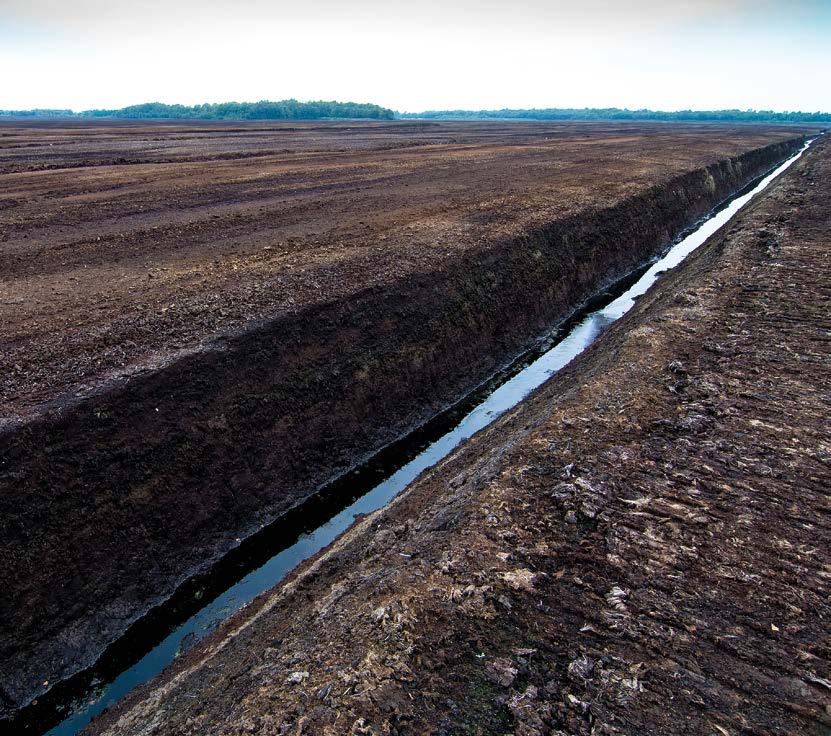
TOP TIPS for peat-free plants
Buy direct from specialist peat-free growers - a quick Google of ‘peat-free plants’ will bring you lots of options.

Grow from seed, bulbs, or buy bare root plants.
Check the labels or ask the question – lots of garden centres will hold a selection of plants that are 100 per cent peat-free, you just have to find out which ones. The more that people ask, the more growers will realise that there is a real demand for peat-free plants.
@Lancashirewildlifetrust 31 @lancswildlife
Dalefoot is a great brand of peat-free compost
Peatlands are destroyed to make compost by Matthew Roberts
Grow your own, help the planet
Are you among the many people out there who have always wanted to grow food but never got round to it? This is the perfect time of year to have a go, says Andrew Mather.

It is often not appreciated how growing some of your own food can be of benefit to your local wildlife. Not only are you avoiding transporting food from afar but you are also providing nourishment for pollinators. Whether you have a windowsill, backyard or large garden there is something you can grow for your kitchen.
There are so many options for things to grow and so much to learn it can feel intimidating and overwhelming to know where to start. Maybe some basic green leaves in the form of lettuce and herbs would be ideal. Ironically these are some of the easiest things to grow whilst per weight being some of the most expensive to buy.
If you have never experienced the joy of seeing a seed that you have planted pop its head up above the earth and show itself transformed into a green shoot then you are truly in for a treat. It is like some form of magic that never wears off, no matter how many years you do it.
Get some peat-free seed compost, which is a finer compost ideal for smaller seeds, and have a go. Very small seeds, such as those of lettuce, need only covering with a fine sprinkle of compost while bigger seeds, such as nasturtiums (another easy wildlife friendly edible flower good for the novice), can be pushed into compost to a depth three times their size before being covered.
www.lancswt.org.uk 32 Gardening
The Witton Park Greenhouse Project
Small shoots can be separated and divided when they are around two inches high and re-planted into individual pots. Ultimately, like looking after our precious Earth, the secret to successful growing is in part down to looking after the soil. Apart from the sun and additional feed you add, any plant will only gain nutrients from the soil/ compost it has access to. It is essential to use peat-free compost as we have learnt to our cost how much damage using peat causes our environment.
It is important to think about what space you have before deciding what to grow. If you have only a yard with no access to the earth the make sure the pots you use are big enough for what you are trying to grow and be aware that you may need to add additional feed to these plants in pots.
If you have a window that faces south and gets lots of sun then this could be a great space to grow some plants such as chillies, basil and tomatoes that enjoy more heat and sun.
More traditional vegetables such as runner beans and beetroot require less sun if you have a shadier spot. Nasturtiums and borage are wonderful wildlife-friendly herbs that are beautiful and easy to grow from seed. If you plant them in the spring you can look forward to a summer of being visited by you local bees and other pollinators.
The Wildlife Trust is involved in food growing projects such as at the Grange Community Gardens in Ribbleton, Preston and at The Greenhouse Project in Witton Park Blackburn.




Pesto recipe
Simply add the following into a blender for some delicious home made pesto
1 healthy bunch of wild garlic leaves
1 healthy bunch of parsley (either flat or curly)
1 healthy bunch of mint leaves
The juice of half a lemon
Toasted nuts and seeds –walnuts and sunflower seeds dry fried in a non-stick pan until golden brown are ideal
Salt and pepper
Olive oil added until you are happy with the texture
Add some nasturtium leaves if you like a little kick in your pesto
Feel free and welcome to come along and see these lovely spaces, join the regular volunteers and get some tips from seeing a wide variety of plants growing in different settings. Community gardening brings the joy of working together without the responsibility of having to do all the work yourself.
Once you have grown some mint or parsley you can combine then with some wild garlic leaves which can be foraged at this time of year to make your own pesto. Enjoy.
@Lancashirewildlifetrust 33 @lancswildlife
"If you have never experienced the joy of seeing a seed that you have planted pop its head up above the earth and show itself transformed into a green shoot then you are truly in for a treat."
Andy helping other to grow
The greenhouses before the project
ere at The Wildlife Trusts, we know how important it is that everyone has the opportunity to get out and enjoy nature. Across the UK, we look after around 2,300 nature reserves to help ensure that no matter where you live, you can enjoy a walk on the wild side. But nature can be sensitive. There are animals that are easily disturbed, plants at risk of trampling. Sometimes we have to impose restrictions to keep wild places wild.
Our communications recently have had a real focus on getting this message out to the public. We know our members are wildlife lovers that truly care about nature, so we wanted to highlight some of the issues that you’re helping us prevent by respecting nature reserves and the special species they protect.

www.lancswt.org.uk 34 Dogs on Leads



@Lancashirewildlifetrust 35 @lancswildlife
Colourful nature hiding under our noses
We often take beetles, bees and moths for granted but three new books focus on these amazing creatures. Alan Wright is loving reviewing them...

Over the past couple of decades bees have become cuddly – they are even the official symbol of Manchester. And we are beginning to understand the huge benefits that bees have on our ecology and, closer to home, about a third of the food that we eat depends on pollinators like the bee.
Our love affair with bees has mainly come because we are willing to look a little closer at these amazing creatures buzzing around our parks and gardens. Most of us adore furry bumblebees. In my garden they bring the place alive with the lovely soft droning, it’s the soundtrack of summer. But it’s not all about bumblebees, many more insects in our gardens can be identified as bees.
This knowledge that there are a lot of different bees out there can be increased by reading Laurence Parker’s Bees of the World. I say reading, it’s a lovely book to leaf through and look at some incredible, colourful images (a theme in all threeof these books). Parker concentrates on bee families so Bombus, which contain our bumblebees, are well represented:
“The diversity of colour patterns among the 280-plus species is enormous, and there is sometimes a bewildering range of colour forms within a species.” I have recorded at least eight different members of the bumblebee family in my tiny garden.
The book also contains a section on my favourite family of bees, andrenidae, commonly known as solitary mining bees. There is sandbank close to the railway that runs along the edge of our Highfield Moss Nature Reserve in Wigan, which is like an apartment block for hundreds of mining bees. You can see them popping out of their holes and heading out, searching for dinner.
Parker gives a real insight into how to identify bees, including details of faces, bodies and how long their tongues are. He has done very well cramming all this information and the family characteristics into just over 200 pages. I would say this isn’t a guide if you are keen to identify UK bees, but if you want to take flight and increase your knowledge and understand how our native bees fit into the planetary bee population this is a lovely companion.
While bees are now the good guys in the insect world, it may be time for others to catch up and get a better reputation. The only time people mention ants is if they get an infestation at home or if they are sitting in the countryside and get ants in their pants.
Last year, I was sitting on a bench watching ants moving leaves. I got close up and got a good view of these remarkable creatures, but not as close as Heather Campbell and Benjamin Blanchard’s book Ants
Again, this is a book to increase your knowledge of creatures that inhabit your bit of the universe, and descriptions of their cousins across the world. The photography in here is quite astonishing, so it’s time to put aside your fear of creepy crawlies and understand these engineers of the animal kingdom.
www.lancswt.org.uk 36 Books
"All three of these books wouldn’t look out of place on your coffee table as they are excellent dippers."
Bees of the World – A Guide to Every Family. Laurence Packer (Princeton University Press).
I really enjoyed the section on Ants and People, explaining how ants “can transform their environment through nest construction and nutrient cycling in ways that affect the entire biological community.”
An army of ants will enhance crops and remove other damaging insects, but others may be detrimental to farming. It’s a balance. This book will definitely increase your understanding of ants.


Finally, The Lives of Beetles, by Arthur V Evans, introduces us to one of the most successful organisms on earth, with more than 400,000 species. That’s more than ten times the numbers of fish, amphibian, reptile, mammal and bird species combined.

Evans says: “The success of beetles is likely due to an ancient body plan that simultaneously allowed them to fly as well as hide in narrow spaces.” They have been around for millions of years. This is a book for knowledge gatherers but will appeal to people who want a bright and colourful extension to some of the beetles you are likely to encounter when you are gardening.
The imagery is stunning because there are some beautiful beetles out there. All three of these books wouldn’t look out of place on your coffee table as they are excellent dippers. All are available from the extensive wildlife library created by Princeton University Press ( press.princeton.edu/books).
@Lancashirewildlifetrust 37 @lancswildlife
Tell your friends the membership means a regular copy of Lapwing and our informative Reserve Guide on joining
The Lives of Beetles – A Natural History of Coleoptera. Arthur V Evans (Princeton University Press).
Ants – A Visual Guide. Heather Campbell and Bejamin Blanchard (Princeton University Press).
I t ’s party time as Decordia joins the fight for nature
Decordia got in touch this year not only to join as a Silver Member to support LWT but also donated to our Peatlands Project, says Megan Kelsall.

Their kind donation will be used in 2023 to support essential maintenance and management work such as scrub control and plant translocations on our peatland reserves.
This in turn will help to protect and improve these remaining fragments of our region’s lowland raised bog. Not only does this mean that the incredible bog can help in the climate fight but can also be home to rare bog species such as the large heath/ Manchester argus butterfly and carnivorous sundews. Here is why Director; Cordelia Ashwell decided to reach out to the LWT:
‘As an event design business, spending five months plus a year in fields around the UK building music festivals, we should have a strong connection with our venues. The same way a city venue might have 14 pillars in the room and 20 types of chairs, the venues we use have trees and plants and insects and animals.
I would love to encourage my clients to understand our venues better and the impact a festival might have on the ecosystem in that green field. To use the festival platform to educate both suppliers and customers about looking after the green space the event occupies as well as putting on a great show.
What has Decordia Ltd implemented to tackle this issue?
Reduce/reuse/recycle is now a concept imbedded in all DECORDIA’s planning and procurement choices. When we design events- we design ‘out’ the waste from the very start, and reinvent using existing materials, using recycling as a final option.
Regeneration is also a really important factor for us. Rather than looking at offsetting our carbon use, how do we seek out and support projects on our doorstep reducing carbon released into the atmosphere and regenerating the crucial biodiversity of the land where our business exists? That’s why we have supported the LWTs Peatland Project this year.
What does nature and wildlife mean to you?
I think being outside and understanding nature has an incredible positive impact on people’s mental health and well-being, and I’d love this to go one step further where it becomes part of our brief to address the impact we have in these spaces and what we can do to help them flourish in the off season.
Any handy recycling tips for our Wildlife Supporters?
In 2022 I reused my 'who gives a crap' toilet paper wrapping to wrap all my Christmas presents for my family and friends and the ribbon was reused from Christmas 2021. What a great idea.
www.lancswt.org.uk 38 Our Corporate Friends
"Reduce / reuse / recycle is now a concept imbedded in all DECORDIA’s planning and procurement choices."
Cordelia Ashwell joined Jenny Bennion at our Little Woolden Moss site to learn more about the power of Peatlands
Standby are making an impact
Standby Productions were on St Annes beach as part of our Fylde Sand Dunes 10th Annual Christmas Tree Planting.
They joined us and a number of local volunteers and community groups to dig trenches and replant donated Christmas trees in order to collect sand and create embryo dunes to grow this habitat, home to lots of highly specialised plants and animals.
Our sand dunes are an effective form of soft sea defence for the local community and a habitat that you can find flowers of international importance, moths and butterflies of UK conservation importance, breeding birds, amphibians and reptiles and a SSSI designation.
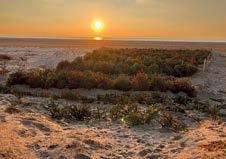
Standby productions also celebrated our partnership by representing SME businesses on the panel of the inaugural Nature North conference. Managing director Simon Owen said: “If everyone did something on a local level, it would have national effect.”
We couldn’t agree more, if your business is looking to make a local impact on nature and wildlife in the region, we would love to hear from you. Get in touch at business@lancwt.org.uk
Wright by name, right by nature
We are pleased to announce that the Eric Wright Group have joined our network of corporate supporters as a gold member.

After several years of supporting LWT with materials that have been used for fencing and pathways we are delighted that Eric Wright Group have committed to engage even more with LWT this year.
The Eric Wright team are looking not only to support projects across the region but to infuse nature and wildlife into their day-to-day operations for their staff and clients.

With the opportunities ranging from teambuilding days, nature talks and wild wellbeing days, we look forward to seeing what 2023 brings for this brilliant partnership.
CORPORATE MEMBERS
GOLD
– Beechfields
– Close Brothers
– Crystal Doors
– Eagle & Child Ramsbottom
– Eco Speed Couriers
– Eric Wright Group
– Gresham Office Furniture
– Mace
– Siemens
– Standby Productions
– Volker Stevin
– VP plc
SILVER
– Decordia Ltd
– Fort Vale Engineering Ltd

– MJ Wilkinson Plant Hire
– Nurturing Hope
BRONZE
– Derek Fox Timber
– Dugdale Nutrition
– Holiday Cottages
– Responsible Mailing
– Valley Mist
– Weinerberger
LOCAL BUSINESS MEMBERS
– Hoofs & Paws
– Su Melville Art
– Morecambe Bay Wills & Estates Ltd
– Worthington Sharpe Ltd
Also special thanks to other businesses that have generated income, taken part in Welly Workouts or given in kind materials and help to projects this last quarter: Siemens, Wildlife Travel, Morgan Sindell Construction, EricWright Constuction, VercoGlobal, Laing.
Our Partnership Officer; Megan had a great time at the The SHE Show North West, a day filled with powerful presentations and insightful conversations, we are incredibly excited to see what 2023 will bring for these innovative and forward thinking companies that are making a difference for the planet.

At Lancashire Wildlife Trust we believe that business charity partnerships should be mutually beneficial and based on shared values. Our partnerships are bespoke not “one size fits all” packages. It’s important to us that we get things right at the start to make sustainable long-term relationships. We believe that your company can benefit greatly from a partnership with Lancashire Wildlife Trust as we help your business and your staff to connect more with nature and thrive from the health and well being that happens from connecting with their outdoor environment.
If your company is interested in being a corporate member go to www.lancswt.org.uk/ how-you-can-help/business
@Lancashirewildlifetrust 39 @lancswildlife
Phil Richardson and Diane Bourne of Eric Wright at Brockholes
Kate Bradbury is passionate about wildlifefriendly gardening and the author of Wildlife Gardening for Everyone and Everything in association with The Wildlife Trusts.


www.lancswt.org.uk 40 Gardening
more tips for helping nature at home from wildlifetrusts.org/gardening
Get


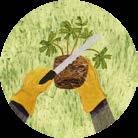


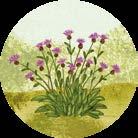
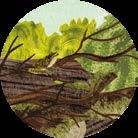

@Lancashirewildlifetrust 41 @lancswildlife
A diverse and wonderful winter
As winter rolls into spring, we saw our landscape change once more. From frost-bitten landscapes in the early morning light, to all kinds of wildlife enjoying the colder temperatures; the past few months have seen some marvellous entries from our amazing photographers, writes Alice Wood .

Your photos
www.lancswt.org.uk 42
Kestrel at Brockholes by Les Price
The photography competition continues to be sponsored by in focus, the binoculars specialist, who very kindly offer a £100 voucher as the prize each month.
Based in the Lookout hide at Brockholes Nature Reserve, in focus have a wide selection of binoculars and scopes to help you keep a closer eye on the incredible wildlife we are blessed with on our reserves.
"Fabulous
photography competition. Fungi truly are fantastic, making up an entire kingdom of their own, with more than 15,000 species growing in the UK.

Alison Holmes claimed top spot with her image of a Kuehneromyces mutabilis, or more commonly known as sheathed wood tuft. The way she captured the colour and detail of this rather advanced organism really made it catch our discerning judge’s eye.
The autumnal landscape never disappoints, and November’s winner Paul Gray manged to capture it perfectly. This shot captures the shadowing of the trees beautifully, whilst still portraying the incredible colour of the evening light shining through. This perfectly captures the theme, ‘Shades of Autumn’.

‘Blackbird in a Christmas Tree’ by Stephen Root hit the mark for our December theme of ‘Christmas Card Wildlife’. The contrast between the black feathers of the bird against the festive green and red of the yew tree really made this photo shine.

This stunning photograph of a kestrel was captured by Les Price at Brockholes Nature Reserve. The snow-covered ground gives this winged beauty a frosty glow and shows off this particular Kestrel’s incredible brown feathers.
Christine Armstrong was selected as the winner of January’s competition with her incredible image of a hare. The ability to capture this magnificent mammal with such clarity allowing the viewer to closely see its incredible features, is very impressive.

This cheeky chappy was caught hunting by Trevor Southward. Weasels are the UK’s smallest carnivore and can be found living in lots of different habitats. This weasel is definitely not camera shy as it poses for this incredible picture, by looking right at the camera and showing off its amazing, elongated body.
As always if you feel inspired to get out in the natural world and capture some wildlife shots after viewing our recent entries, why not enter our competition? Take a look at this month’s theme and submit your entries to photocomp@lancswt.org.uk

Fungi" was the theme of October’s
Alison Holmes
Paul Gray
Stephen Root
@Lancashirewildlifetrust 43 @lancswildlife
Christine Armstrong
Trevor Southward
What ’s On this spring
Spring is the most wonderful time of the year. Our nature reserves are bursting with birdsong, blooming with spring flowers and buzzing with the first insects. Blow off those winter cobwebs and explore!
Den Village
13th April
Brockholes Nature Reserve
£8.00 per child
Join us at Brockholes this Easter for our Den Building Challenge!
Will you and your family take on the challenge? Work together to build a magical den village deep within our woodlands, this activity is certain to be fun for the whole family.
Dinosaur Adventure
12th and 14th April
Brockholes and Mere Sands
Wood Nature Reserve
£8.00 per child
Wander down to the woodland to take part in our Dinosaur Adventure. This session includes a whole host of prehistoric fun such as; digging for fossils and taking part in our egg hunt.
Toddle Together
Every Thursday
Brockholes Nature Reserve Free!
Join us for a 1 hour walk around the reserve on buggy friendly paths aimed at toddlers and preschoolers.
Brockholes Car boot Sale
30th April and 28th May
Brockholes Nature Reserve
Normal parking charges apply for visitors
Car boot sales are a great way to recycle your treasures or pick up some bargains. Come along to Brockholes this summer for a morning of eco-friendly, guilt-free shopping.
PBFA Book Fair
7th and 8th July
Brockholes Nature Reserve Free!
Join us at Brockholes for our amazing PBFA Book Fair! Organised by the Provincial Booksellers Fairs Association, we will have thousands of second-hand, antiquarian and rare books for sale from dealers around the UK.
Head to lancswt.org.uk/ events for more information, booking details and more events for you to enjoy
Nature Kids at The Hive
6th and 13th April
The Hive at Moss Bank Park
£8.00 per child
Explore the natural world of The Hive this Spring. Let your little ones get in touch with wildlife and explore our various natural habitats.
Happy Hoppy Easter
8th and 9th April
The Hive at Moss Bank Park
£9.00 per child
Take part in our Happy Hoppy Easter event. Go on an egg hunt, create your own bunny ears and paint a willow egg to take home with you.
Easter Themed Beach Art
18th April Beach Café Fylde Free!
Grab your buckets and spades and join us on the beach to create some "eggcellent" Easter-themed sand sculptures!
www.lancswt.org.uk 44 What's On
Easter Egg(case) Hunt
19th April
North Beach Car Park, St Annes Free!
Join us this Easter for an egg hunt with a twist! We'll be exploring the strandline in search for Mermaid's purses!
Fylde Sand Dunes Guided Walk
7th May, 4th June, 2nd July
North Beach Car Park, St Annes Free!
Come along and discover the wonders of the Fylde sand dunes with our passionate and informative volunteers.
Seashore Detectives
31st May
North Beach Car Park, St Annes Free!
Get your wellies on and become a seashore detective with us as we explore the beach, dunes and strandline on the Fylde coast.
Mud Dipping
1st June
Beach Café Fylde
Free!
Join us this May half-term on St Anne's beach as we discover the mysterious muddy creatures living in the Ribble Estuary!
Mere Sands Wood Artisan Markets
3rd and 4th June
Mere Sands Wood Nature Reserve
Join us for a weekend of wonderful Artisan Markets at Mere Sands Wood. Open to the public from 10am until 4pm, these markets are a brilliant opportunity to enjoy local businesses, treat yourself or a loved one, and experience a wonderful day out at one of the North West's most loved nature reserves.
Great Easter Egg Case Hunt

Friday 7th April
Meeting point:
Rossall Point Tower – Fleetwood
We will be hunting for shark, skate and ray eggcases (mermaid’s purses) along the shore.
Story Time on the Beach
Thursday 20th April
Meeting point:
Rossall Point Tower – Fleetwood
Join us for a beach themed storytelling session with a difference! Find out about the little cucumber fish.
Coastal Birdwatch
Friday 12th May
Meeting point:
Knott End Slipway – Knott End on Sea
Join us on the coast for an exciting bird watch event on your local coastline looking for wading and seasonal species with a bird specialist.
Story Time on the Estuary
Tuesday 30th May
Wyre Estuary Country Park
Join us for an estuary themed story time session with a difference! Learn all about the wonderful little cucumber fish.
Marine Life Sand Sculptures
Thursday 1st June
Mary’s Shell, Cleveleys Beach
Help us make mini marine creature sand sculptures on the beach.
Bat Walk
Monday 10th April
Lunt Meadows Nature Reserve
Join us for an evening looking for bats (and any other nocturnal creatures) at Lunt Meadows.
Panning for Stone Age Treasures
Wednesday 12th April
Lunt Meadows Nature Reserve
Step back in time at our drop-in archaeological skills activity all about the Stone Age.
Small Mammal Surveying Workshop
Thursday 13th April
Lunt Meadows
Using humane traps, you will help the team weigh, identify, and record species in our meadows. This is a great opportunity to get up close to voles, mice, and shrews, and learn all about these tiny but important creatures.
Xplorer Challenge
Various dates over the Easter period Brockholes Nature Reserve
Explore Brockholes, find the markers, complete the challenge and have fun together!
Willow Lantern Workshop
Wednesday 12th April
Brockholes Nature Reserve
Come along and get creative in our Easter craft session. We'll be making willow lanterns to decorate your home!
@Lancashirewildlifetrust 45 @lancswildlife


www.lancswt.org.uk 46 UK News
Plotted plants
The Wildlife Trusts are co-sponsoring production of the Botanical Society of Britain and Ireland (BSBI) Plant Atlas 2020, which is published this March. The Atlas is based on more than 30 million records collected by thousands of botanists between 2000 and 2019, providing


an unrivaled picture of the changing distribution and fortunes of plants in Britain and Ireland. This knowledge is likely to provide evidence to help us protect nature across the UK.
Find out more bsbi.org/atlas-2020
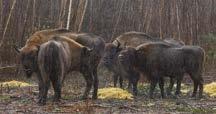
@Lancashirewildlifetrust 47 @lancswildlife




Thank you for all of your support @Lancashirewildlifetrust @lancswildlife Go wild for wildlife in your garden this year and apply for our Wildlife Gardening Award! Visit www.lancswt.org.uk/my-wild-garden for more information






























 Emma Bartlett Volunteer Manager
Emma Bartlett Volunteer Manager








































 Eric
Eric













































